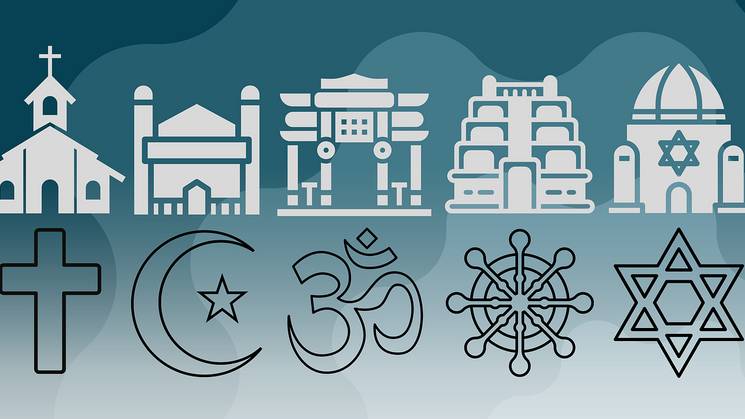Libros Sagrados

Desde los albores de la humanidad, la escritura ha sido un puente entre lo terrenal y lo divino. A través de ella, las diferentes tradiciones religiosas han plasmado su sabiduría, revelaciones y principios, otorgando a ciertos textos un carácter sagrado. Estos libros no solo transmiten doctrinas y normas, sino que son también expresión de una búsqueda espiritual que atraviesa los siglos y las culturas.
En esta exposición, presentamos los textos sagrados de cinco grandes tradiciones religiosas, cada uno con su propia historia, significado y mensaje.
---
Since the dawn of humanity, writing has been a bridge between the earthly and the divine. Through it, different religious traditions have captured their wisdom, revelations, and principles, granting certain texts a sacred character. These books not only convey doctrines and norms but also serve as an expression of a spiritual quest that transcends centuries and cultures.
In this exhibition, we present the sacred texts of five major religious traditions, each with its own history, significance, and message.


La Biblia (Cristianismo): Es el libro sagrado del cristianismo, compuesto por el Antiguo Testamento y el Nuevo Testamento. En ella se encuentran los relatos de la creación, la historia del pueblo de Israel, la vida y enseñanzas de Jesús, y la misión de sus seguidores. Es fuente de fe, inspiración y guía para millones de personas en todo el mundo.
La palabra Biblia viene de βιβλίον en griego, que significa libro. El Antiguo Testamento hace referencia a la historia del Pueblo de Israel desde la creación hasta antes de la venida de Jesús; está dividido en el Pentateuco (los 5 primeros libros), los Históricos, los Proféticos y los Poéticos. El Nuevo Testamento cuenta de 66 libros entre los que se encuentran los cuatro Evangelios (San Mateo, San Marcos, San Lucas y San Juan), los Hechos de los Apóstoles, las Cartas y el Apocalipsis.
La Biblia, al ser una recopilación de varios libros escritos en diferentes momentos históricos cuenta con varias versiones, la versión católica cuenta con 73 libros, 46 del Antiguo Testamento y 27 del Nuevo, mientras que las Biblias protestantes suelen tener 66 libros, dejando por fuera 7 libros del Antiguo Testamento, los llamados Deuterocanónicos.
---
The Bible (Christianity): It is the sacred book of Christianity, composed of the Old Testament and the New Testament. It contains the accounts of creation, the history of the people of Israel, the life and teachings of Jesus, and the mission of his followers. It is a source of faith, inspiration, and guidance for millions of people around the world.
The word Bible comes from the Greek βιβλίον, which means "book." The Old Testament refers to the history of the people of Israel from creation up to the time before the coming of Jesus. It is divided into the Pentateuch (the first five books), the Historical books, the Prophetic books, and the Poetic books. The New Testament consists of 66 books, including the four Gospels (Matthew, Mark, Luke, and John), the Acts of the Apostles, the Letters, and the Book of Revelation.
Since the Bible is a compilation of several books written at different moments in history, there are various versions. The Catholic version includes 73 books—46 in the Old Testament and 27 in the New Testament—while Protestant Bibles usually contain 66 books, omitting seven books from the Old Testament, known as the Deuterocanonical books.

La Torá (Judaísmo): Corresponde a los cinco primeros libros de la Biblia hebrea y constituye el núcleo de la tradición judía. Contiene la historia fundacional del pueblo de Israel, así como la Ley revelada por Dios a Moisés en el monte Sinaí, siendo un texto esencial para la identidad y práctica religiosa del judaísmo.
La Torá está formada por los libros del Génesis, Éxodo, Levítico, Números y Deuteronomio que tratan no solo del origen de los israelitas sino de todo el mundo. La palabra hebrea “Torá” significa enseñanza, instrucción o ley, de manera que en sus libros se recogen las enseñanzas de Dios al Pueblo de Israel. La Torá no debe confundirse con otros libros hebreos de gran importancia para el culto religioso, como el Talmud, el Tanaj o la Mishná.
---
The Torah (Judaism): The Torah comprises the first five books of the Hebrew Bible and forms the foundation of Jewish tradition. It contains the origin story of the people of Israel, as well as the Law revealed by God to Moses on Mount Sinai. As such, it is an essential text for Jewish identity and religious practice.
The Torah includes the books of Genesis, Exodus, Leviticus, Numbers, and Deuteronomy, which speak not only about the origins of the Israelites but also about the creation of the world. The Hebrew word Torah means “teaching,” “instruction,” or “law,” and its contents reflect God's teachings to the people of Israel. The Torah should not be confused with other significant Hebrew texts used in Jewish religious life, such as the Talmud, the Tanakh, or the Mishnah.

El Corán (Islam): Es el libro sagrado del islam, considerado por los musulmanes como la palabra de Dios revelada al profeta Mahoma a través del arcángel Gabriel. Escrito en árabe, el Corán abarca enseñanzas sobre la fe, la moral, la justicia y la vida en comunidad.
El Corán está formado por 114 capítulos, llamados “suras” que tienen una longitud variable, que a su vez se dividen en versículos llamados “ayat”. En total, el Corán tiene 6.236 ayat. Cada parte del Corán tiene un propósito y un significado específicos en la vida espiritual y religiosa de los musulmanes. La Al-Fatiha o primera sura del Corán también conocida como “La apertura” se recita en cada ciclo de la oración islámica (salat).
---
The Qur'an (Islam):The Qur'an is the sacred book of Islam, regarded by Muslims as the word of God revealed to the Prophet Muhammad through the Archangel Gabriel. Written in Arabic, the Qur'an contains teachings on faith, morality, justice, and community life.
The Qur'an is composed of 114 chapters, called surahs, which vary in length and are further divided into verses known as ayat. In total, the Qur'an contains 6,236 ayat. Each part of the Qur'an holds specific meaning and purpose in the spiritual and religious life of Muslims. The first surah, Al-Fatiha—also known as “The Opening”—is recited in every cycle of Islamic prayer (salat).

El Bhagavad-gītā (Hinduismo): Es un diálogo filosófico y espiritual dentro del Mahabharata, una de las grandes epopeyas hindúes. En él, el dios Krishna instruye al guerreo Arjuna sobre el deber, la devoción y el camino hacia la liberación espiritual.
Este libro cuyo nombre significa La canción de Dios es el texto sagrado hindú por excelencia que contiene enseñanzas filosóficas y espirituales. Se compone de 700 estrofas escritas en sánscrito en el que se combinan conceptos expresados en los textos fundamentales del hinduismo, los Vedas y los Upanishads, y los sintetiza en una visión única y coherente de creencia en un solo Dios y en la unidad subyacente de toda la existencia.
---
The Bhagavad-gītā (Hinduism): The Bhagavad-gītā is a philosophical and spiritual dialogue that forms part of the Mahabharata, one of the great epics of Hinduism. In it, the god Krishna instructs the warrior Arjuna on duty, devotion, and the path to spiritual liberation.
The name Bhagavad Gita means “The Song of God,” and it is considered the most important sacred text in Hinduism, offering profound philosophical and spiritual teachings. It consists of 700 verses written in Sanskrit, blending concepts from the foundational Hindu scriptures—the Vedas and the Upanishads—into a unique and coherent vision that emphasizes belief in one God and the underlying unity of all existence.

El Tipitaka (Budismo): Es la recopilación de las enseñanzas de Buda y constituye el fundamento del budismo Theravāda. Se divide en tres grandes secciones, denominadas pitaka, que significa “cesta” o “canasta”, en referencia a los recipientes donde se guardaban los manuscritos escritos en hojas de palma. Por esta razón, el canon es conocido tradicionalmente como Tripiṭaka (“tres cestas”):
Vinaya Pitaka (“Cesta de la disciplina”): trata sobre las normas y la vida disciplinaria de la sangha (la comunidad budista). Sutta Pitaka (“Cesta de los discursos”): contiene sermones y enseñanzas atribuidas al Buda, así como poesía religiosa. Abhidhamma Pitaka (“Cesta del conocimiento superior”): reúne tratados filosóficos que desarrollan las doctrinas budistas, especialmente sobre la mente y la realidad.
Aunque el canon fue transcrito hace unos dos mil años, su origen oral sigue presente en la práctica budista: la memorización y la recitación continúan siendo formas comunes de estudio y transmisión.
---
The Tipitaka (Buddhism):The Tipitaka is the collection of the Buddha's teachings and forms the foundation of Theravāda Buddhism. It is divided into three main sections, called pitaka, meaning "basket," in reference to the containers in which palm-leaf manuscripts were stored. For this reason, the canon is traditionally known as the Tripiṭaka ("three baskets"):
Vinaya Pitaka ("Basket of Discipline"): Deals with the rules and the disciplinary life of the sangha (the Buddhist community). Sutta Pitaka ("Basket of Discourses"): Contains sermons and teachings attributed to the Buddha, as well as religious poetry. Abhidhamma Pitaka ("Basket of Higher Knowledge"): Gathers philosophical treatises that elaborate on Buddhist doctrines, especially those concerning the mind and reality.
Although the canon was transcribed about two thousand years ago, its oral origins remain present in Buddhist practice: memorization and recitation continue to be common methods of study and transmission.
Estos textos más que simples libros, son testimonios de fe, tradición y trascendencia. A través de ellos, generaciones han encontrado guía, consuelo y sentido, recordándonos el poder de la palabra escrita para conectar lo humano con lo sagrado.
---
These texts are more than just books, they are testimonies of faith, tradition and transcendence. Through them, generations have found guidance, solace and meaning, reminding us of the power of the written word to connect the human with the sacred.
